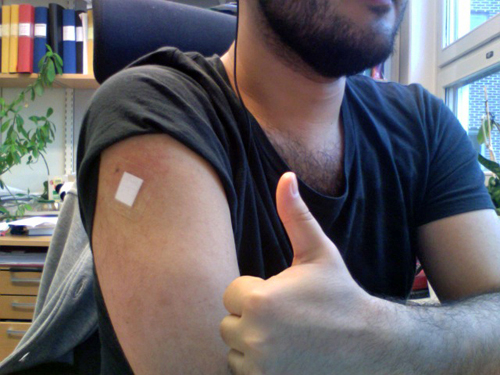
I chose to get vaccinated for the seasonal flu this year as well! This is my post from last year. In general it's a good idea to get vaccinated, even if you're young and healthy. If nothing else, make it a yearly statement in the face of the anti-vaccination loonies. Last year I got vaccinated for both the seasonal flu and the H1N1 or "swine" flu. Understandably last year's relative hysteria about swine flu is nowhere to be seen this year. Today I was the only one in the waiting hall at the clinic waiting to be vaccinated. But whatever happened after last year's hysteria? Wonder no more, there's an article out in BMC Biology summarizing the development of the H1N1 flu since last year's pandemic.
In 2009, the new H1N1 pandemic virus exhibited several features that distinguished it from seasonal influenza: it caused major outbreaks in the northern hemisphere summer and autumn, it quickly dominated over other influenza viruses circulating in humans, and it caused widespread disease because of the lack of significant population immunity, particularly in young people. In 2010, the pandemic virus is behaving more like a seasonal influenza virus in that summer outbreaks have not been seen, it is co-circulating with seasonal A(H3N2) and B viruses, and the intensity of transmission is now lower than in 2009. For these reasons, the World Health Organization (WHO) downgraded its pandemic alert from phase 6 to the post-pandemic phase on 10 August 2010. Fortunately, in contrast to descriptions of the 1918 Spanish influenza pandemic, there has been no apparent change in disease severity over the first 18 months of circulation of this virus.
What about vaccination then?
Fortunately, our worst fears were not realized in the influenza A (H1N1) 2009 pandemic. However, despite all the advances in technology, surveillance and pandemic planning, the virus spread globally within months, reminding us how difficult it is to control. <...> While some quarters have criticized the response as excessive, it is likely the pandemic would have posed a greater problem in the absence of such interventions.
Initial clinical trials demonstrated that the monovalent influenza (H1N1) 2009 vaccine is immunogenic and capable of inducing levels of antibody that are considered protective. There is also evidence that vaccination reduces not only the risk of infection but also subsequent transmission to others. Vaccination remains the single most effective method of protection from influenza.
That said, it may still be too early to tell just how effective vaccination against the pandemic virus has been. There are two reasons for this. The first is that the initial roll-out of the vaccine occurred too late to affect the first pandemic wave. <...> It will be interesting to see whether the delay in onset of the influenza season and its relatively low activity is due to the extensive vaccination program. We have to wait and see.
The article also details why the susceptibility was so high in young people (lack of immunity), why some people where so severely affected (lack of immunity and lowered inflammatory response), and why the virus spread so fast (large pool of susceptible individuals due to... you guessed it, lack of immunity). Get the picture?
Turner, S., Doherty, P., & Kelso, A. (2010). Q&A: H1N1 pandemic influenza - what's new? BMC Biology, 8 (1) DOI: 10.1186/1741-7007-8-130
No comments:
Post a Comment
Note: Only a member of this blog may post a comment.